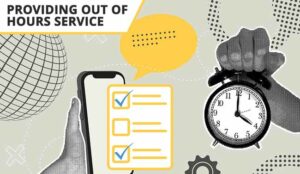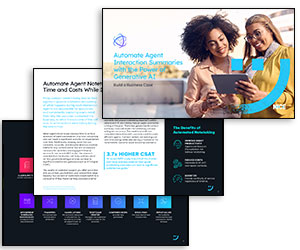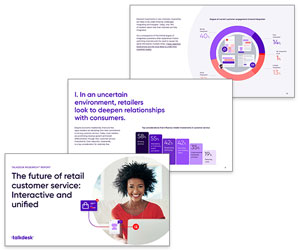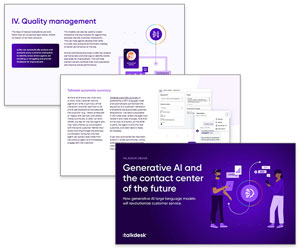Unless you’re running a 24/7 operation, at some point, your contact centre will have to close – but what then happens to the customers who still try to reach you?
To give an in-depth answer to that question, we asked our readers, “what’s the best way to provide out of hours service?”.
Here, they share their lived experiences, and various pros and cons, of the most common out of hours service options you could try, so you can make an informed choice about how to provide a great service experience – even when your contact centre is closed.
The ‘Skeleton Staff’ Option
According to our LinkedIn poll, 37% of our readers have ‘skeleton staff always around’ to support customers outside of core business hours.
As the most popular response, this highlights that many contact centres do, in fact, make a strategic decision to keep a small group of agents on shift – also known as having ‘skeleton staff’ – to directly manage any customer queries that come in during unsociable hours, and largely eliminate the need for any investment in alternative methods of out of hours support.
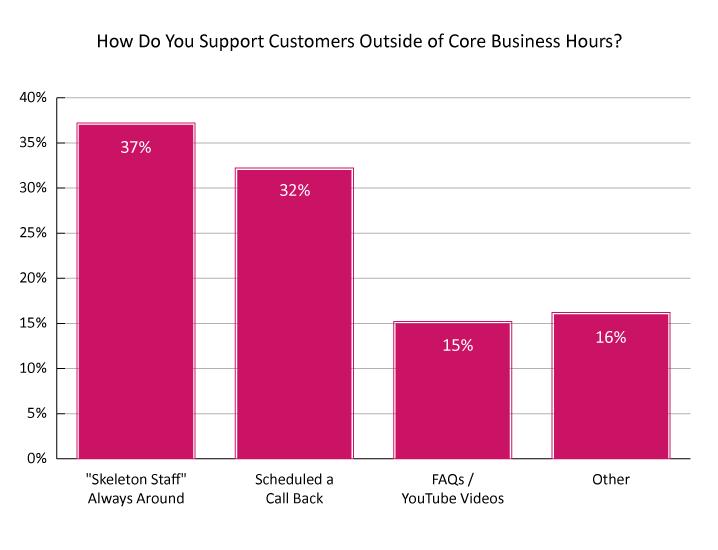
| Customer Support Option | Response % |
|---|---|
| “Skeleton Staff” Always Around | 37% |
| Scheduled a Call Back | 32% |
| FAQs / YouTube Videos | 15% |
| Other | 16% |
The Pros and Cons of Operating With ‘Skeleton Staff’
Here are some of the pros and cons our readers have experienced with a ‘skeleton staff’ out of hours strategy:
An Individual’s Reliability Can Make or Break This Strategy
There aren’t any drawbacks for us right now, but it depends on the reliability of your after-hours staff as to how successful this approach is.
Contributed by: Sam, a BPO provider based in New Zealand
It’s More Challenging to Cope With Demand Variation
One of the main issues with skeleton staffing for me is the limited capacity to cope with demand variations.
Also, the time it takes to ensure that our out of office team is sufficiently skilled to handle all contact channels.
Contributed by: Scott, a BPO provider for UK and South Africa
Sickness Can Have a Huge Impact on This Already-Thin Resource
Our ‘skeleton staff’ approach puts a huge pressure on our management team, who sometimes have to step in to help solve unforeseen staffing events
We’ve found that our ‘skeleton staff’ approach puts a huge pressure on our management team, who sometimes have to step in to help solve unforeseen staffing events – for example, sickness, accidents, and technical issues – as the team is already quite thin, so these shifts can have a huge impact on our operation if they aren’t staffed at full capacity.
Contributed by: Andre, Head of Customer Experience in the Retail Sector
It’s Best to Hire People Who Specifically Want to Work the Night Shift
We experienced issues when we put night shifts into our fixed rotation.
Our solution to this was hiring people that specifically wanted those hours.
Contributed by: Amy, a member of our LinkedIn community
Regular Night Shifts Can Tire Out Your Team
If you don’t have enough staff to provide long enough gaps between each night shift, it’s draining to the team – especially if they are required to do it more than once a month.
Contributed by: Sophie, a Call Centre Helper reader
It Can Be Tough to Give Agents Enough Work to Do Overnight
One of the main the challenges with maintaining a ‘skeleton staff’ strategy is low occupancy and giving them enough work to do overnight between contacts coming in.
For example, it’s a great opportunity to clear down email queues, but who really wants a response at 3am?
Contributed by: Andrew, Global Director of Workforce Planning in the Travel Industry
You Can’t Put a Price on Being There for Your Customers When They Need You
One of the biggest pros for the ‘skeleton staff’ approach is being there for your customers when they need you… You just can’t put a price on that!
One of the biggest pros for the ‘skeleton staff’ approach is being there for your customers when they need you
Contributed by: Beth, a Call Centre Helper reader
A ‘Follow the Sun’ Staffing Model Can Help Cover the Night Shift
To combat inevitable staffing challenges, you can try building a ‘follow the sun’ model and utilizing different time zones to your advantage – if you have the means to do so.
Contributed by: Kate, a member of our LinkedIn community
You Might Have to Pay More for Overnight Staff
The only drawback for me is the legal 35% labour uplift on base salary that we must pay in the Dominican Republic.
Contributed by: Stuart, a nearshoring provider in the Dominican Republic
Higher Than Expected Volumes Can Lead to Calls Being Abandoned
The main risk with a ‘skeleton staff’ strategy is someone from the skeleton crew getting higher than expected volumes.
It can’t be helped, but if there is a spike in the call-flow, then calls get abandoned.
Contributed by: Brian, a member of our LinkedIn community
We have practical steps you can take to handle high call volumes in our article: Call Volumes Up? Here’s What You Can Do About It
Putting Agents “On Call” Requires an Investment in Mobile Phones
To help manage out of hours calls, we tried a campaign of agents being “on call”, but to make this work, we had to give them mobile phones, pay “on call” pay, and upgrade our software to accommodate this.
Contributed by: Desiree, a representative of the medical equipment manufacturing industry
Escalations Can Be Trickier to Handle
Typically during ‘skeleton staff’ shifts, the volume and nature of contacts is unknown.
It’s especially challenging as, during that time, scheduled resources are dependent on someone being around with the right amount of experience to manage any escalations.
Contributed by: Gautam, a global outsourcing provider
For advice on call escalations, read our article: How to Design an Escalation Matrix for Call Centre Agents
You Have to Be Clever About Agents Completing Extra Tasks
The most noticeable drawback is expense. We’ve found we must schedule 3FTE in the unsociable hours to cover any annual leave or unplanned leave (like sickness).
To mitigate that expense, we identify tasks which can be completed during quieter periods, such as end of day reporting and sharing insight into what our customers are telling us.
Contributed by: George, a representative of Transport for London
It Often Just Doesn’t Make Financial Sense for Low Volumes
The biggest drawback is ensuring the staff working after hours have sufficient work.
A lot of times, financially, it just doesn’t make sense to have after hours support for low volume interactions.
Contributed by: Hao, a representative of the entertainment industry
If you want more information on staffing, read these articles next:
The ‘Schedule a Callback’ Option
The option to schedule a callback is another popular choice for out of hours customer service – used by 32% of our readers, as seen in our poll on ‘How do you support customers outside of core business hours?’
The Pros and Cons of Scheduling a Callback
You Can’t Be Sure When Someone Will Choose to Be Called Back
There can be drawbacks to offering customers the option to schedule a callback – the main one being the impact on your Workforce Management (WFM).
This is because you can’t be sure when someone will choose to be called back – unless you limit the available windows for them to choose from.
Contributed by: Pierre, a Workforce Management Analyst in the surveillance industry
Agents Will Always Have to Acknowledge the Previous Disappointment
The agent doing the callback needs to acknowledge the previous disappointment of not being able to get through to a live agent
The crux of the conversation is lost if the agent doing the callback fails to acknowledge the previous disappointment of not being able to get through to a live agent, or to summarize the conversation accurately.
Contributed by: Adarsh, a representative of the travel industry
Outbound Contact Can Compromise Your Inbound Service Levels
There are drawbacks to a callback strategy – mostly on staffing.
For example, if an inbound contact centre shuts down its operations at 10pm each night and provides customers the option to schedule a callback for the next day, then the very next day that contact centre will need to give over X number of staff to making outbound contacts only.
Unless this is managed well, this will ultimately impact the service level promised to customers.
Contributed by: Arun, a representative of the online retail industry
Increased Loyalty to Your Services
Whilst you will have to spend more time and add cost, your customers will feel cared for, which may increase their loyalty to your services.
Contributed by: ErZi, currently working in the telecommunications industry
If you are looking for advice on improving customer loyalty, read our article: 11 Tips to Create and Maintain Loyal Customers
It’s More Effective in a 7-Day Working Week Than a 5-Day Working Week
I find that the ‘callback’ approach is only suitable for the 7-day working environment – not for a 5-day working week.
This is because a customer trying to contact support on a Friday night won’t be able to arrange a callback until Monday morning – and such service is an unsuitably delayed approach.
Contributed by: Krishanu, with expertise in retail and insurance
It Might Take More Than One Call Attempt to Get Back in Touch
The only drawback we have encountered so far is that it might take more than one call to get back to the customer, and so we may not reach them at their most convenient time to talk.
Contributed by: Shahin, a member of our LinkedIn community
We have some great articles on callbacks, which you should read next:
The ‘FAQs / YouTube Videos’ Option
A series of informative, up-to-date FAQ and YouTube video resources can help customers find the answers they need when the contact centre is closed – an approach relied on by 15% of our readers, according to our poll on ‘How do you support customers outside of core business hours?’
The Pros and Cons of FAQs / YouTube Videos
Using Top Call Reasons to Define Priority Order for the Development of Guides Has Been Very Well Received by Customers
We developed our user and troubleshooting guides primarily to meet growing customer desire to self-serve.
We defined our approach by identifying top call reasons and using this insight as a priority order for the development of guides and materials.
Expanding our support to YouTube last year has been extremely well received by our customers and has bolstered our self-help offering significantly.
Contributed by: Kevin Sampson, Head of Customer Excellence at Zen Internet
Easy-to-Read Articles Can Stop Customers Calling Back the Next Day
I believe you can do great self-service by focusing on comprehensive and easy-to-read articles – supported by YouTube content.
My first choice would be to have staff 24/7, but with the costs in mind, I believe you can do great self-service by focusing on comprehensive and easy-to-read articles – supported by YouTube content.
People might even choose not to call back the next day if you do your articles right.
Contributed by: Jørn, a representative of the manufacturing industry
YouTube Videos Can Be More Frustrating Than Useful
YouTube is not interactive and, if the pace is wrong, it can lead to many frustrating replays while customers try to get the answer they need.
Contributed by: Martine, a representative of the charity sector
YouTube Videos Can Show Customers Exactly How to Do Things
As the second most used social platform, it only made sense that we built a presence on YouTube where our customers are likely already spending time.
It provides an ideal medium in which to show customers exactly how to perform tests and diagnostics, make changes, and set up functionality.
Contributed by: Kevin Sampson, Head of Customer Excellence at Zen Internet
Some Customers Get Confused With YouTube Videos
I find customers get confused with our YouTube videos or simply don’t want to try them.
Contributed by: Paz, a Call Centre Helper reader
If They Don’t Like the FAQ Articles, Customers Just Have to Wait Until You Open Again
We have a help centre page to enable self-service with FAQ articles.
Truthfully, if that doesn’t work for them, then customers will have to wait until a member of the team is available within our operational hours. It’s just how it goes.
Contributed by: Stuart, a representative of the Department for Education
If you are looking for best practices for customer service knowledge bases, read our article: 26 Best Practices for a Customer Service Knowledge Base
Actively Refreshing Self-Help Material Increases Use Rates
Don’t leave your self-help material to gather dust!
Since beginning our project to build and refresh all our content, we’ve seen a 200% increase in the use of our self-help material, as well as a reduction in contacts relating to these topics.
Contributed by: Kevin Sampson, Head of Customer Excellence at Zen Internet
Giving customers access to the right information can be tricky. Read these articles next for advice on ways to do this:
The ‘Automating Customer Interactions / Chatbots’ Option
Another way to offer out of hours service is to automate customer interactions (via chatbots, for example) to give customers the support they need when a human agent isn’t available.
The Pros and Cons of Automating Customer Interactions
Most Things Can Be Done Using a Chatbot or Voicebot
As standard, we work from 9am to 5pm and we always have someone on duty 24/7, but most things can be done by using our chatbot or voicebot.
Contributed by: Kamil, a regular Call Centre Helper reader
We’ve Had Really Positive Feedback About Our Chatbot
We push customers to our website when our call centre is closed, so that customers can self-serve.
We have minimal traffic outside normal business hours, but we do have a chatbot that we’ve had really positive feedback about.
Contributed by: Sarah, a member of our LinkedIn community
Want to know how well your chatbot is performing and judge the quality of your customer interactions? Read our article: How to Measure Chatbot Performance
Stressful Circumstances Are Better Handled With a Human Touch
Depending on the industry your customers are in, severe weather warnings and/ or power outages (for example) can all cause a massive influx of calls.
Of course, these can be combated through technology, but in my experience, these customers (in such a stressful situation) prefer a call to be answered by a human rather than a bot.
Contributed by: Paul, a business process consultant
Chatbots Can Improve NPS and Lower Cost (When Set Up Correctly!)
I would most definitely recommend other contact centres invest in a chatbot.
When correctly set up, we’ve found it’s improved our NPS and lowered cost.
Contributed by: René, working in the mobility sector
To avoid your chatbot gaining notoriety for bad behaviour, read our article: F*** This! How to Make Sure Your Chatbots Don’t Swear at Customers
We Get Less Complaints About Self-Service Now We Have a Chatbot
Before the chatbot, we got more complaints about self-service than we do now.
Quite simply, your self-service options need to be good!
Contributed by: Lorna, a representative of TomTom
For more information on automation and chatbots, read these articles next:
The ‘Outsourcing’ Option
Another option to support your customers when the contact centre is closed is to outsource enquires elsewhere.
The Pros and Cons of Outsourcing
You Don’t Have to Pick Up Extra Work the Next Day
When customers try to contact us outside of our core hours, they are now helpfully picked up by our outsourced out of hours team.
This has been a positive change for our core team, as they pick up as normal first thing in the morning with the new queries coming in – instead of trying to catch up from the night before.
Contributed by: Sophie, a regular Call Centre Helper reader
Customers Can Help Customers!

An alternative outsourcing model is using GigCX – essentially customers helping customers – as an additional resource pool.
If the interaction is digital in nature – via messaging or chat, for example – then you could route that enquiry to a pool of pre-vetted customers for resolution.
This can give more flexibility and operational agility in handling peaks when there is insufficient internal resource available – that isn’t as limited by operating hours.
Contributed by: Paul Weald, The Contact Centre Innovator
You’ll Need Different Levels of Support for Specific Issues
We have an out of hours answering service which is subcontracted out.
Even then, for specific scenarios, customers will need to ring “on call” staff – who are either covering core services, or a wider range of niche issues.
Contributed by: Katy, a member of our LinkedIn community
Outsourcing Simply Isn’t an Affordable Option for Smaller Operations

From my experience, when it came to working with smaller teams or newer operations, we simply did not have the bandwidth or budget to provide out of hours service, so instead we had to communicate with our customers as clearly as possible!
For example, we had a message on our website and an autoresponder in place that said, “our teams aren’t currently available, but we open at 8am tomorrow and will respond then”.
Most importantly of all, we followed through and did what we said we’d do, so customers trusted our service.
Contributed by: Jenny Dempsey, Community & Customer Service Leader
If you are thinking about outsourcing, you should read these articles next for more information:
Whatever You Offer, You Must Start by Understanding the Customer’s Intent!
Remember the adage that “Good customer service costs less than bad customer service”?
When it comes to offering out of hours service that works, always start by understanding the customer’s intent. This helps determine the immediacy of the issue and the best next steps.
Contributed by: Paul Weald, The Contact Centre Innovator
Are You Doing Something Different in Your Contact Centre?
If you think we’ve missed anything in our round-up of out of hours service solutions, join our community group on LinkedIn and let us know!
Looking at how to improve your customer service, and for information on contact centre opening hours? Read these articles next:
- Finding the Ideal Opening Hours for Your Contact Centre
- What Are the Best Opening Hours for a Call Centre?
- What Are the Industry Standards for Call Centre Metrics?
Author: Megan Jones
Published On: 2nd Sep 2024 - Last modified: 9th Sep 2024
Read more about - Customer Service Strategy, Automation, Business Process Outsourcing (BPO), Call Back, Chatbots, Customer Service, Editor's Picks, Jenny Dempsey, Knowledge Management, Paul Weald, Staffing, Top Story, Video Solutions





